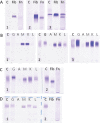Cryofibrinogen-Characteristics and Association with Cryoglobulin: A Retrospective Study Out of a Series of 1,712 Samples over 7 Years
- PMID: 37072111
- PMCID: PMC10289831
- DOI: 10.1055/a-2075-8204
Cryofibrinogen-Characteristics and Association with Cryoglobulin: A Retrospective Study Out of a Series of 1,712 Samples over 7 Years
Abstract
Objective: Cryofibrinogens (CFs) and cryoglobulins (CGs) are cryoproteins responsible for obstructive vasculopathy and vasculitis. The aim of this study was to compare the characteristics of CF and CG, and to define the conditions of their association.
Methods and results: This retrospective study was conducted at the Lyon University Hospitals, and included patients with at least one sample tested for CF and/or CG between September 2013 and April 2021. Serum and plasma samples were analyzed in very strict conditions of temperature. After cold precipitation, CF and CG were characterized and quantified in the cryoprecipitates. CRP and plasma fibrinogen levels were also investigated. Over this 7-year period, 1,712 samples for CF detection and 25,650 samples for CG detection were sent to the laboratory. Simultaneous testing of CF and CG was performed in 1,453/1,712 samples (85%). CF was less often positive than CG (8.3 vs. 13.5%, p < 0.0001). In positive CF samples, CG was associated in 28.9% of cases. In CF, fibrinogen was associated with fibronectin in 98/142 (69%) samples, especially in highly concentrated CF. CF concentration was independent of C-reactive protein and plasma fibrinogen concentrations.
Conclusion: The simultaneous detection of CF and CG is essential for the diagnosis of vasculitis or thromboembolic events and their treatment.
The Author(s). This is an open access article published by Thieme under the terms of the Creative Commons Attribution-NonDerivative-NonCommercial License, permitting copying and reproduction so long as the original work is given appropriate credit. Contents may not be used for commercial purposes, or adapted, remixed, transformed or built upon. (https://creativecommons.org/licenses/by-nc-nd/4.0/).
Conflict of interest statement
None declared.
Figures




Similar articles
-
Cryofibrinogenaemia: a study of 49 patients.Clin Exp Immunol. 2000 May;120(2):253-60. doi: 10.1046/j.1365-2249.2000.01210.x. Clin Exp Immunol. 2000. PMID: 10792373 Free PMC article.
-
Cryofibrinogenemia: a marker of severity of cryoglobulinemic vasculitis.Am J Med. 2015 Aug;128(8):916-21. doi: 10.1016/j.amjmed.2015.03.009. Epub 2015 Mar 28. Am J Med. 2015. PMID: 25827358
-
Cryoproteins.Ann Med Interne (Paris). 1986;137(3):254-9. Ann Med Interne (Paris). 1986. PMID: 3767197
-
Cryoglobulinemic vasculitis: pathophysiological mechanisms and diagnosis.Curr Opin Rheumatol. 2021 Jan;33(1):1-7. doi: 10.1097/BOR.0000000000000757. Curr Opin Rheumatol. 2021. PMID: 33186245 Review.
-
[Cold labile serum and plasma proteins: clinical and diagnostic significance of cryoglobulins, cryofibrinogen and cold agglutinins].Immun Infekt. 1994 Oct;22(5):169-76. Immun Infekt. 1994. PMID: 7982712 Review. German.
Cited by
-
Renal Involvement in Mixed Cryoglobulinemic Vasculitis: Current Perspectives.J Clin Med. 2025 Jun 19;14(12):4369. doi: 10.3390/jcm14124369. J Clin Med. 2025. PMID: 40566113 Free PMC article. Review.
-
Laboratory Practices for the Detection and Characterization of Cryoglobulins and Cryofibrinogen.J Clin Lab Anal. 2025 Aug;39(15):e70074. doi: 10.1002/jcla.70074. Epub 2025 Jul 19. J Clin Lab Anal. 2025. PMID: 40682370 Free PMC article.
References
-
- Moiseev S, Luqmani R, Novikov P, Shevtsova T. Cryofibrinogenaemia-a neglected disease. Rheumatology (Oxford) 2017;56(09):1445–1451. - PubMed
-
- Stathakis N E, Karamanolis D, Koukoulis G, Tsianos E. Characterization of cryofibrinogen isolated from patients plasma. Haemostasis. 1981;10(04):195–202. - PubMed
-
- Smith S B, Arkin C. Cryofibrinogenemia: incidence, clinical correlations, and a review of the literature. Am J Clin Pathol. 1972;58(05):524–530. - PubMed
-
- Saadoun D, Elalamy I, Ghillani-Dalbin P, Sène D, Delluc A, Cacoub P. Cryofibrinogenemia: new insights into clinical and pathogenic features. Am J Med. 2009;122(12):1128–1135. - PubMed
-
- Michaud M, Pourrat J. Cryofibrinogenemia. J Clin Rheumatol. 2013;19(03):142–148. - PubMed
MeSH terms
Substances
LinkOut - more resources
Full Text Sources
Medical
Research Materials
Miscellaneous

